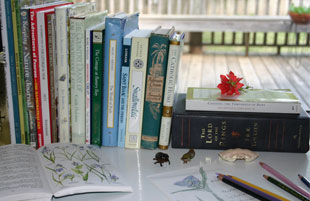| Author | |
SuzanneG
Forum Moderator


Joined: June 17 2006
Location: Idaho
Online Status: Offline
Posts: 5465
|
| Posted: April 18 2007 at 6:29pm | IP Logged
|
 |
|
This came up in this thread in the Catholic Mosaic Forum as a result of discussing A Peek Into My Church .
What are the regulations/rules/standards about making communion hosts? Can someone give us a link or something?
__________________
Suzanne in ID
Wife to Pete
Mom of 7 (Girls - 14, 12, 11, 9, 7 and Boys - 4, 1)
|
| Back to Top |


|
| |
MaryM
Board Moderator


Joined: Feb 11 2005
Location: Colorado
Online Status: Offline
Posts: 13104
|
| Posted: April 18 2007 at 6:45pm | IP Logged
|
 |
|
From the Catholic United for the Faith tract "Proper Matter for Bread and Wine Used in Consecration"
Valid Matter
The Church has followed the example of Christ by making use of bread and wine with water to celebrate the Lordís Supper. The bread must be unleavened and made from wheat.
It follows that bread made of any substance, or to which has been added so great a quantity of any other substance than wheat that according to common estimation it cannot be said to be wheat bread, cannot be valid matter for the performance of the Sacrifice and the Consecration of the Sacrament of the Eucharist.[2]
The meaning of the sign demands that the material for the Eucharistic celebration truly have the appearance of food. It is therefore expedient that the eucharistic bread, even though unleavened and baked in the traditional shape, be made in such a way that the priest at Mass with a congregation is able in practice to break it into parts for distribution to at least some of the faithful. Small hosts are, however, in no way ruled out when the number of those receiving Holy Communion or other pastoral needs require it. The action of the fraction or breaking of bread, which gave its name to the Eucharist in apostolic times, will bring out more clearly the force and importance of the sign of unity of all in the one bread, and of the sign of charity by the fact that the one bread is distributed among the brothers and sisters [3]
[2] Congregation for the Sacraments, instruction (Dominus Salvator Noster), March 26, 1929; English translation in Canon Law Digest, vol. 1, 355; from Acta Apostolicae Sedis (AAS), 21 (1929), 631-639. The AAS is the Vatican periodical in which official Church documents are published.
[3] General Instruction to the Roman Missal
__________________
Mary M. in Denver
Our Domestic Church
|
| Back to Top |



|
| |
JennGM
Forum Moderator


Joined: Feb 07 2005
Location: Virginia
Online Status: Offline
Posts: 17702
|
| Posted: April 18 2007 at 7:13pm | IP Logged
|
 |
|
From Ceremonies of the Modern Roman Rite: The Eucharist and the Liturgy of the Hours by Peter J. Elliott
This is the best summary, because it refers to the documents, Code of Canon Law (CIC), General Instruction on the Roman Missal (GIRM), and Inaestimabile Donum but puts it all together so well:
The Matter of the Sacraments
143. However beautiful the vessels and vestments we set aside for the liturgical celebrations, the matter used for the sacraments is a more fundamental responsibility of the celebrant. The principles governing the matter for the Eucharist are simple. Problems only develop when complications are introduced.
144. The bread for the Eucharist in the Roman Rite is unleavened wheaten bread.46 It should be made from the finest quality plain wheat flour mixed with pure water. It should be carefully baked so as to be a palatable food that is neither too hard nor uncooked.
145. It is prudent always to use bread prepared professionally by those who observe Church law and custom rather than to allow others to bake bread according to "recipes". Wholemeal wheaten flour may be used to emphasize the food sign but surely not the coarser forms of wholemeal where the grain is still largely intact. However, adding other kinds of flour, chemical colorings, oil, shortening, salt, sugar, honey, etc., renders the matter invalid or at least doubtful. No priest may use doubtful matter for the Eucharist. The emphasis placed on the food sign in the General Instruction refers to the texture of the bread47 and should be interpreted in terms of the cultural context. Many cultures are familiar with white bread as a staple food.
146. The traditional round form of the host is always required,48 a simple evocative symbol of unity and perfection. The large bread may be of the traditional dimensions, varying slightly from country to country (just over 7 cm. or 2-7/8 inches diameter in Rome). Such a host also fits the lunette of a monstrance. It customarily bears some sacred symbol and is usually marked in such a way as to be divided at the faction, with a section marked on the left side to form the particle to be placed in the chalice. These traditional "wafers" should be more substantial in texture than in the past.
147. A larger host to be broken into fragments may conveniently have a diameter of between 15 to 20 cm. (about 6 to 8 inches), depending on the number sharing in the "one Bread" and taking into account the dimensions of the large paten. Such a host should be marked before Mass so that it may be broken easily at the fraction. It should not be of exaggerated proportions, which could cause ridicule and obvious inconvenience. On certain occasions it may be preferable to use several large hosts.
148. When people's hosts are used, it seems preferable that they should be of substantial texture and of reasonable proportions (3.5 cm. or 1-3/8 inches in diameter in Rome), not the small particles used in some places (about 2 cm. or 3/4 of an inch). In some places these hosts are made with a sealed edge to solve the problems of fragments when the Eucharist is placed in the hand.
149. The bread for the Eucharist should always be fresh. It is strongly favored that the people receive particles consecrated at the Mass in which they participate. Moreover, care should be taken to renew the particles in the tabernacle at least every two weeks, preferably more frequently.49 In the Roman Rite there is no provision for reserving intincted Hosts, that is, Hosts which have been dipped in the Precious Blood.
46. CIC, Canons 924 #2, 926; GIRM, no. 282.
47. Cf. Inaestimabile Donum, no. 8
48. Cf. GIRM, no. 283, "forma tradita confectus", and see Inaestimabile Donum, no. 8.
49. A reasonable way of observing CIC, Canon 939.
__________________
Jennifer G. Miller
Wife to  & ds1 & ds1  '03 & ds2 '03 & ds2  '07 '07
Family in Feast and Feria
|
| Back to Top |



|
| |
SuzanneG
Forum Moderator


Joined: June 17 2006
Location: Idaho
Online Status: Offline
Posts: 5465
|
| Posted: March 10 2010 at 11:46pm | IP Logged
|
 |
|
This came up again tonight, and thought I'd bump since Mary and Jenn's info is above. It's pretty interesting....kids are REALLY enthralled with the details of communion hosts.
Also, someone linked this video a couple years ago, that is fascinating.....for all ages  . It's a video of The Cavanaugh Company, who makes most of the hosts in the United States and Canada. It shows their factory in operation. And, the article is interesting. . It's a video of The Cavanaugh Company, who makes most of the hosts in the United States and Canada. It shows their factory in operation. And, the article is interesting.
__________________
Suzanne in ID
Wife to Pete
Mom of 7 (Girls - 14, 12, 11, 9, 7 and Boys - 4, 1)
|
| Back to Top |


|
| |
TxTrish
Forum Pro


Joined: Oct 23 2005
Location: Pennsylvania
Online Status: Offline
Posts: 321
|
| Posted: March 11 2010 at 7:06pm | IP Logged
|
 |
|
My eldest daughter went to a Carmelite Convent to see the nuns maiking the hosts (in OK) before she received 1st Communion years ago -
Hubby was newly Catholic and he really found the experience fascinating.
__________________
+JMJ+
Gabrielle20, Deavon18, Elizabeth12, Mary10, Greg8
and a grandson!
My Blog
"Duty before everything, even something holy"
St.Padre Pio
|
| Back to Top |


|
| |
|
|


 Topic: Making Communion Hosts
Topic: Making Communion Hosts






 & ds1
& ds1  '03 & ds2
'03 & ds2  '07
'07
 . It's a video of The Cavanaugh Company, who makes most of the hosts in the United States and Canada. It shows their factory in operation. And, the article is interesting.
. It's a video of The Cavanaugh Company, who makes most of the hosts in the United States and Canada. It shows their factory in operation. And, the article is interesting. 
